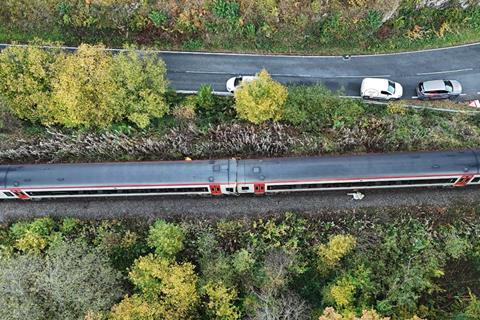UK: The sanding hoses on the leading vehicle of the Transport for Wales Class 158 diesel multiple-unit which passed through the passing loop at Talerddig and collided with an oncoming train were blocked and unable to discharge sand, the Rail Accident Investigation Branch has said.
In an update issued on November 5, RAIB said initial analysis of information from the on-train data recorder showed that the driver of westbound train 1J25 applied service braking as it neared the loop where it was due to stop to allow eastbound train 1S71 to pass on October 21. Around 40 sec after the first service brake application, the OTDR records an emergency brake demand being made and remaining in place until the collision. OTDR data shows that wheel slide started during service braking and was constant during emergency braking.
Although 1J25 slowed while passing through the loop, it did not stop. It exited the loop and continued to travel for around 900 m on a descending gradient before colliding with 1S71.
One passenger died and four other people were seriously injured, with 11 more people requiring hospital treatment.

RAIB said there is conflicting evidence relating to the speed of the trains at the point of collision. Initial analysis indicates that 1J25 was travelling at between 24 and 39 km/h, while train 1S71 was travelling at around 10 km/h.
Both the two-car Class 158 DMUs involved were fitted with wheel slide protection systems and an automatic sanding system which discharges sand automatically via sanding hoses when wheel slide is detected during braking. This is intended to increase the available friction at the wheel/rail interface.
However, an inspection of the automatic sanding system fitted to train 1J25 after the accident showed that the sanding hoses on the leading vehicle, which would have been active at the time of the accident, were blocked and apparently unable to discharge sand.
Following the accident, RAIB found low wheel/rail adhesion levels at various locations near the accident site.
The ongoing investigation will seek to identify the sequence of events which led to the accident; the level of wheel/rail adhesion; the status and performance of the braking, wheel slide protection and sanding systems on train 1J25; the behaviour of both trains during and following the collision; the policies of Network Rail and Transport for Wales relating to low wheel/rail adhesion and managing risk on the line; the processes used to assess and control the risk of overrun; and any relevant underlying factors.
In a joint statement following the RAIB update, Transport for Wales and Network Rail said they had carried out enhanced checks to the trains and line to enable reopening on October 28. They added that ’at this early stage of the investigation, it’s fundamental that we await the findings of the full report and show sensitivity towards our customers, colleagues, the local community and the families of those affected by the incident’.
